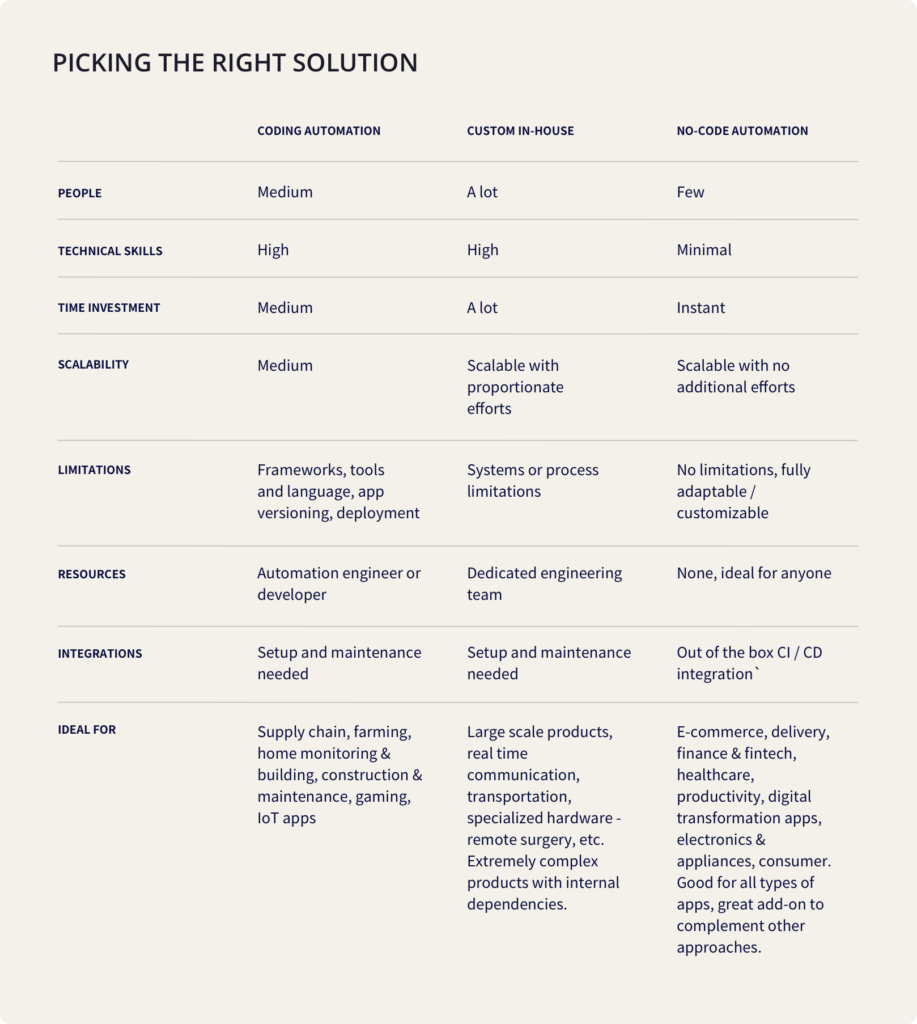Software testing is taking rapid strides towards innovation and is ceaselessly enhancing and progressing with the changing technological landscape. Likewise, the software testing market is expanding quickly.
In such growing market, enterprises must choose the required tools, frameworks, and processes to optimize their software development lifecycles wisely. However, testing and verifying for the right software behavior is an undeniably difficult issue which the QA and engineering teams must manage. Since, for a profoundly lengthy and complex code, regular testing techniques are a bit insufficient in themselves.
The unseen defects (bugs) in the software code will bring about operational malfunctioning, information disclosure, theft vulnerability, as well as serious monetary harm. This product testing challenge is an issue which the organizations of the present world can’t disregard. Thus, there is an undeniable requirement for better technologies (such as automation) and an equally compelling product or engineering strategy to ensure a seamless customer experience.
By utilizing automated testing, one can drastically improve the quality of product, accelerate the cycle of software testing and widen the testing coverage. However, there are tons of challenges in applying test automation. Hence, it becomes important to choose the right test automation strategy.
Sofy is a powerful testing platform that helps customers of all sizes, from small companies (with our self-service platform) to the huge tech giants (with our product as well as managed services). In this blog post we will talk about our learnings working with all types of customers, guide you on ways to create a compelling QA approach for your product and the choice between the coding automation, a customized solution or no-code automation.
Are you an engineer or product leader? Consider the following while building the QA strategy for your product

Since quality is the sole factor that distinguishes competitive products, product and engineering leaders have a key role to perform. Among their plenty of roles and responsibilities, they need to oversee and lead the whole QA team for the powerful quality assurance strategy of the product. While building an effective QA strategy for their products, they must keep the following aspects in mind:
- Fast Delivery: While customers demand frequent updates for the products, quick delivery has become a default requirement for almost each and every organization in the world. Product leaders need to maintain a sweet balance between quality as well as fast delivery at the same time. Adopting automation and making QA testing part of your development lifecycle can help more informed decisions about the development process along with better control over the software quality.
- Avoiding re-work: Defining righteous requirements upfront aids in keeping away from superfluous re-work during the software development lifecycle. The prerequisites should be clear and succinct, however, should have the necessary feedback from different concerned stakeholders. Building smooth coordination among testing and other teams will help in building the right products in the first run.
- Removing bugs and issues in the code: Since nobody in this world is perfect. It becomes impossible to prevent bugs in the code. However, a proper QA strategy can decrease the bug encounters down the line. As a product lead, you must encourage your team members to keep code simple, observe error patterns, split code into small chunks and create testable codes to fix the respective issues.
- Maintain Documentation: During the entire product lifecycle, the product and engineering leaders should maintain detailed documentation of the vital information of the product. Documenting the information about software performance, errors, their resolution, and future development work will help you to effectively channelize your teams to achieve the desired product outcome.
A team of skilled Quality Assurance engineers is must to achieve the desired results. QA engineers have to break down the test cases and their outcomes to discover the persisting flaws. The QA team is answerable for distinguishing and resolving defects in the product. QA engineers need to know precisely when and where they need to engage in what type of testing mechanism to best suit the test case.
Let us now consider the various techniques and how the QA teams can incorporate them in the software testing cycle.
1. Coding automation
With the rapid increase in usage of software development frameworks and technologies, there has been substantial development within the QA field and we have seen a rise of automation for QA. Most companies have started scripting their QA testing to execute automatically on certain triggers.
While automating various business processes of the product, running tests on multiple devices, integrating test cases inside the CI/CD pipelines, code automation is usually use due to its seamless integration with the Agile process. Let us see the advantages offered by the coding automation:
Advantages:
- Quick Turnaround: While developing any software, it undergoes several rounds of testing with multiple scenarios and test runs. It usually gets too clogged up to keep up with the entire software lifecycle and without having a clear insight into the product it becomes very hard to identify where the real bottleneck resides. However, Test Automation along with automated structured reporting helps to easily identify and rectify the bugs in the code.
- Save Cost: Apart from speed, coding automation has another vital benefit in reducing the costs significantly. With the advent of coding automation, companies have been requiring very few manual testing resources, which has reduced a lot of hiring expenses. Moreover, it has eased the companies to deliver products faster, and thus the requirements for the testing resources have also scaled down.
- Quickly Rebuild Development Environments: The most concerning issue with most projects is the error between how the product runs in testing conditions, contrasted with the production environment. The code developed in one environment will work diversely in another and there exists a continuous tussle between the different teams of the project (namely development, testing, and deployment) regarding the development environment required to run the code successfully. As a viable solution to overcome this conflict of development environment between the teams, automation can eliminate it by rapidly rebuilding the correct development environment.
- Integration and Simulation: Technological advancements such as virtualization, containerization, cloud computing, and micro-services have made it simple for QA to set up and deal with an application under test [AUT]. These advancements give adaptability and moment arrangement of an intricate test environment at each phase of a lifecycle. The test environment is exactly similar to a real customer usage environment and could be managed from any location making it simpler for testers to test from any place and anytime.
Disadvantages:
- Scripts not scalable: One big drawback to the coding automation is that code scripts cannot be scaled at all. This is why coding automation needs a high level of maintenance. If the application under test evolves, so should the automation scripts. If the scripts are not up-to-date, major code automation errors are observed.Usually, because of the non-sync representation of the current implementation in the product, many such scripts no longer are applicable. Coding automation is not a one- off effort during the overall lifecycle. It takes a great deal of time, effort and resources to maintain all the automation scripts. The required automation scripts must be kept up to date and relevant to make the best of the coding automation.
2. Custom in-house solutions
When coding automation is not enough, a lot of companies tend to build their own custom in-house testing product to progressively work with the ever-evolving business requirements. Companies having extremely complex products with several internal dependencies such as cloud service providers, database and payment applications and many more require a custom in-house testing product to test their products performance.
In essence, if the project demands of the following, the organization can choose the in-house solution:
- When coding automation is unable to meets business requirements.
- To hold the maximum control over the project.
- Due to security concerns and restricting any data/information breach.
- To avoid cultural limitations such as time zone differences, language barriers, and many others that could affect the product lifecycle.
- When companies want to make releases every few minutes or hours
Having a custom solution as a part of the organization, allows you to achieve maximum customization for every minor tech need of the product. A custom in-house solution can help the product managers to inculcate appropriate changes in the product lifecycle whenever needed. In addition, a custom in-house solution help to develop a better application customization, modernization, and management.
However, customized solutions require far too many resources, in terms of workforce and infrastructure. For an in-house testing solution, several professionals are required to build it. In addition, the costs for having such a large number of individuals on board at the same time could itself go into a few million dollars. Besides all the salaries of the employees, the capital for the infrastructure required for the customized solution will be spent on a recurring basis.
Such a custom solution not only demands a lot of resources but also accumulates an additional overhead on both product managers and the engineering teams. Despite working for the product lifecycle, the product managers are required to oversee the role of the departments involved in developing customized solutions. In addition, a dedicated engineering team is needed for these solutions to meet the constantly evolving specifications.
Big tech companies that use custom in-house solutions:
- Facebook: At Facebook, most of the engineers’ responsibility is to check the quality of the code. The core software delivery at Facebook expands on a “Push from Master” approach, which means there’s no release branch acting for the product. This method guarantees quick delivery, yet it requires thorough testing.
- Uber: At Uber, live monitoring and automation are critical to protecting commercial well-being, maintaining reliability, and gaining productivity in business sectors. Thus, they are highly reliant on their testing teams for error-free software.
3. No-code automation
Though coding automation and customized solution may be suitable for some applications and products, most businesses and use cases don’t have such direct technical requirements. In addition, the coding automation and customized solutions requires substantial investments and capital for operating. Therefore, most of the AGILE organizations concentrate in developing their core resources rather than spending on such expensive solutions. There is no point in directing the developers of the organization to write automation codes. An impactful solution is to enable the manual testers with no-code software products to boost the testing lifecycle.
No code automation permits the technical and non-technical users to automate the processes through a graphical user interface rather than computer programming. This user does not need to have prerequisite know-how about the coding as the no-code tool GUI includes drag and drop functionality that imitates the user’s interactions with the software. The thought behind the method is that a tester manually sets up the test, which the tool records click by click. Then it creates a script to automate the actual test itself. The testers can likewise alter the script to an extent in the testing cycle to best suit their prerequisites.
Whether you consider it no code automation, it isn’t really ”codeless.” Truth be told, while you record the test steps, the automation tool creates the code required to drive test automation. Hence, the automation tool creates an abstraction layer, which interprets fundamental user interactions with the code. Therefore, one can focus on developing various test situations and evaluating the product’s user experience instead of battling with creating the code to test.
Companies working in the domain of Banking and Financial Services, Healthcare and Life Sciences, Retail and Ecommerce, Manufacturing and several others should definitely use no-code automation in their product lifecycle. However, each and every company can keep no-code solution ready as a backup to sustain their testing cycles in case of any technical urgency.
Advantages:
- No coding expertise needed, no setting up environments: No-code automation can be used to test an application without writing a single code snippet or setting up environments. It makes the setup so easy to utilize, that automating a test takes less time and requires practically no coding efforts.
- Saves time: No code automation can easily reduce the arduous tasks of days to a couple of man-hours. It helps teams in effectively reproducing tests automatically across different builds, languages, and devices. In addition, it provides instant access to an enormous library of devices to test the application under real-world conditions to identify the undetected defects.
All things considered, which solution is best?
All the automation testing mechanisms hold their own benefits at their individual places. It is the requirement of the product for which the engineering and product leaders can choose from the above mechanisms.

Since, traditional human centric testing is incapable of scaling at the pace of the software release. There comes strong responsibility on engineering leaders to facilitate the testing phase in order to meet the product deadlines and expectations.
For such products with conditional workflows, custom controls and functionalities, the engineering leads can choose coding automation as a solution. Apart from code automation, a no-code solution provides a powerful point-and-click interface, that can be even used by anyone in the team to seamlessly innovate the product workflows without requiring any significant coding skills.
It saves a lot of time and will help the product leaders to quickly serve the customer requirements without overcomplicating the engineering pipeline. Furthermore, many businesses prefer to develop their own individual in-house testing products to gradually deal with constantly changing market needs if coding automation is not enough. Thus, the selection depends entirely on the requirement for the product. However, no solution among all is entirely capable of working with all the requirements.
The engineering leaders must choose a ‘Hybrid Solution’ for their projects. This includes breaking down the projects into sub-parts and using different automation mechanisms for each part as required. It helps in managing the workload and making the tasks easier.
By expanding the productivity and viability of the project using the hybrid solution, you can improve adaptability of the processes to the project. Hybrid solution provides the accessibility to develop and modify the tests according to the code subsets and their need. Moreover, it significantly reduces the test maintenance effort, and gives better manageability of test cases and their executions, providing extended capabilities over the long run.









